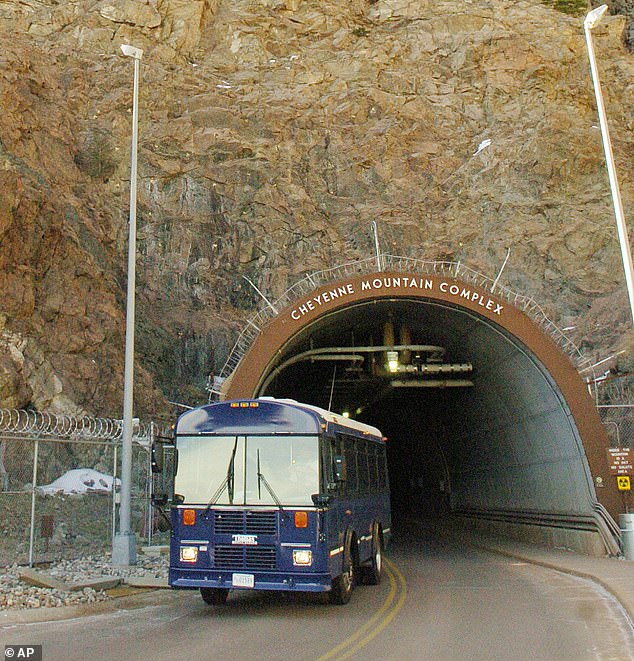Deep beneath the Colorado Rockies lies a top-secret fortress designed to keep America’s military and political leaders alive if the unthinkable happens.
The Cheyenne Mountain Complex, once the stuff of Cold War nightmares, is a sprawling underground city carved out of nearly 700,000 tons of granite and designed to withstand direct nuclear strikes.
For decades, it has stood ready to coordinate US defenses in the event of Armageddon.
The last time reporters were allowed inside was in 2018, when Donald Trump was still in the White House.
Now, amid mounting international tensions, the US military has again opened its blast-proof doors – with NewsNation cameras escorted deep into the classified facility.
Behind three-foot-thick steel doors and past multiple checkpoints, reporters were shown the command post that military officials say could withstand a nuclear explosion ‘one thousand times stronger than the bomb dropped on Hiroshima’ even from just a mile away.
The complex is more than just a bunker – it is a functioning underground city. It has its own power plant, underground lakes for drinking water, and stockpiles of food to sustain crews for ‘a very long time.’
A Subway restaurant even operates inside, proudly calling itself the ‘most secure Subway’ in the world.

The tunnel entrance to the Cheyenne Mountain Complex, carved into solid granite near Colorado Springs

Armed guard walking past one of the blast-proof chambers inside the facility

Cold War-era photo of U.S. staff manning communications consoles inside the mountain
Gen. Gregory Guillot, commander of U.S. Northern Command and NORAD, told NewsNation the facility remains as vital today as when it was first activated in 1966.
‘It is truly worth whatever they paid for it back in the early ’60s, and we are using it today just as they did the decades before,’ Guillot told the outlet.
Asked about modern threats – from Russian jets probing US airspace to Chinese surveillance balloons and cyberattacks – Guillot told NewsNation he was unshaken.
‘I don’t worry. We got the greatest military members working it,’ he said, before adding ominously: ‘And we are ready.’
The installation spans 5.1 acres and contains 15 buildings suspended on massive springs to absorb the shock of a nuclear blast.
Known as the ‘battle deck,’ it would serve as the command hub for US and Canadian forces if disaster struck.
Completed in 1966 at a cost of $142 million, the Cheyenne Mountain fortress would cost well over $1 billion if built today. At the height of the Cold War, it was billed as ‘the most secure place on Earth’ – a warren of tunnels and blast chambers designed to protect against Soviet missiles.
‘We like to say it’s the most secure facility in the world,’ Steve Rose, the base’s deputy director, told reporters during a 2018 tour.
The granite and steel also shield electronics from electromagnetic pulses unleashed by nuclear explosions. Hydraulic machinery can seal the enormous blast doors in just 45 seconds – or, in an emergency, by hand.

The Cheyenne Mountain Complex command center, where operators monitor threats to U.S. airspace

Visitors pass through the giant steel blast doors that guard the underground base

A Canadian general inside NORAD’s operations center during joint defense exercises

NORTHCOM staff on duty at Peterson Space Force Base in Colorado Springs

A worker walks the long corridor leading deep into the classified NORAD facility
The doors were famously shut on 9/11, the only time since the Cold War they’ve been sealed during a real-world crisis.
Once NORAD’s primary headquarters, the facility shifted to an alternate command role in 2008, with its main operations now at Peterson Space Force Base in Colorado Springs.
But staff still rotate through Cheyenne Mountain to ensure readiness, and officials insist it is no relic.
‘Couldn’t be farther from the truth,’ Rose said in 2018, noting permanent NORAD contingents still operate there alongside cyber, space, and intelligence units.
The complex has also become a pop culture icon – immortalized in the 1983 film WarGames and the Stargate TV series.
If the unthinkable were to happen, America’s continuity plan is already mapped out.
The President would first be rushed into the White House’s underground shelter, the Presidential Emergency Operations Center, according to the White House Historical Association.
If time allowed, he would then be flown aboard one of the Air Force’s E-4B ‘Doomsday’ jets – airborne command posts described by the U.S. Air Force as designed to keep the chain of command intact even if Washington was under attack.
Alongside the President would be a tight circle of officials: the Defense Secretary, the Joint Chiefs of Staff, and military aides carrying the nuclear ‘football’ that contains the codes needed to order a strike.
The Vice President is protected separately to guarantee succession, while other Cabinet officials and congressional leaders would be moved to hardened continuity sites such as Mount Weather in Virginia or Raven Rock in Pennsylvania, according to FEMA.
Cheyenne Mountain, meanwhile, would continue its Cold War mission.
NORAD describes the underground base as a hardened alternate command center that provides early warning of missile launches, tracks incoming aircraft, and feeds data to the Pentagon and to the President’s airborne command post.
This article was originally published by a www.dailymail.co.uk . Read the Original article here. .

